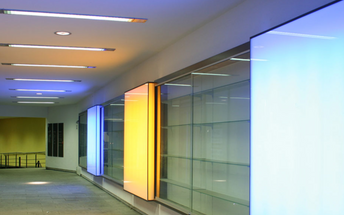FAQ Acrylic & Clear Plastic
Is acrylic more expensive than polycarbonate?
No, pricing on standard stock acrylic is typically 25% less expensive than the same sized piece of polycarbonate. Pricing can fluctuate based on availability to material and required size.
What’s the difference between extruded acrylic and cast acrylic?
Extruded acrylic is less expensive than cast acrylic. Extruded acrylic will tend to have a grain in the direction of the extrusion which will affect the properties. Cast is acrylic is cast between glass plates and has better optical properties and surface quality. Thickness tolerance is tighter with extruded and extruded acrylic cements easier. There is greater strength and weather resistance with cast acrylic.
What’s the difference between acrylic and polycarbonate?
Extruded acrylic typically costs less, has a higher gloss finish, better scratch resistance and is more transparent than polycarbonate. Polycarbonate is virtually indestructible. Both are much lighter in weight than glass and more impact resistant (acrylic 17 times more and polycarbonate is 250 times more). Neither acrylic nor polycarbonate will shatter. Both can come in bullet-resistant grade, however, the polycarbonate can handle higher caliber.
Is plastic bullet proof?
No, there are no grades of clear plastic sheet that are considered “bullet proof.” There are laminated grades of both polycarbonate and acrylic that are UL-approved to withstand ballistic assault based on caliber of weapon and grade of ammunition. These materials would be considered bullet resistant or ballistic-grade.
Can I use glass cleaner on acrylic?
It is not recommended to use household glass cleaners on plastic materials is it typically contains ammonia and other chemical additives which harm and slowly deteriorate the material (commonly called crazing). Ammonia specifically will damage the surface and compromise the transparency of an acrylic sheet. Mild soapy water applied with soft cloth and rinsed with plain water is the safest and most effective method of cleaning acrylic.
What are face shields made from?
Clear face shield parts are commonly made from a .020 to .040 inch thick piece of polycarbonate, PETG, acetate or acrylic. The material is often die-cut or routed into shape. Thinner, disposable face shields are available.
Does acrylic block UV light?
Acrylic is inherently UV resistant, blocking approximately 93% of UV light. There are grades of acrylic with UV additives allowing the material to block as much as 99% of UV light.
How much does a sheet of acrylic cost?
A standard size sheet of acrylic is 48 x 96 inches (4 x 8 feet) and cost will depend on the thickness of the sheet. An approximate price for a quarter-inch thick sheet of clear extruded acrylic is $100. Price will vary based on exact product, color, quantity ordered, shipping and other common factors.
How do you make a display case?
Display cases are typically made from 5 clear acrylic panels and sit on a metal, colored plastic or wood base. Acrylic can be cut with standard wood-working equipment. Thinner gauges can be scored with a knife. A solvent-based cement specific for acrylic should be used to bond the panels together. Acrylic panels can also be bent by heating the material to approximately 200 degree F.
How do you cut acrylic?
Thin gauge acrylic can be scored with a knife. Thicker gauge acrylic can be cut with standard wood-working tooling, both hand-held and electric. Carbide blades are recommended.
What material is used to make greenhouses?
Multi-wall material, also called twin wall or corrugated, in either acrylic or polycarbonate is a popular material for greenhouse manufacturing due to its light weight, impact strength, relative low cost and formability. The sheets can be connected using H channels, tape, nails or screws.
What is a light diffusing panel?
A light diffusing panel is commonly made from acrylic and used as light fixture covers, dispersing the light transmission evenly from the source, reducing or eliminating hot spots of light. These are needed more than ever since the advent of LED lighting. Eggcrate-pattern polystyrene is also commonly used in lighting applications.
What plastic is best in direct sunlight?
Most acrylics will allow light of wavelength greater than 375nm to pass through. However, UV wavelengths are lower (e.g. UV-C is 100-290 nm) and will not pass through acrylic. HDPE products can include a UV inhibitator, making it ideal for outdoor application such as patio furniture and in boats.
What’s the difference between Plexiglass and acrylic?
Plexiglas is a brand of acrylic and a term commonly used to describe a clear plastic sheet. There are many brands of acrylic products including Lucite, Optix, Chemcast, Polycast and ACYRLITE.

